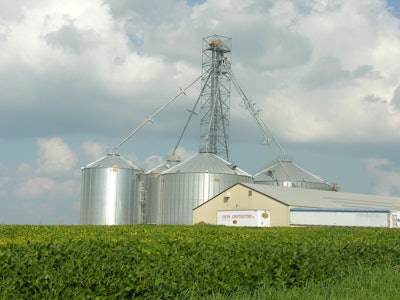
The Butler company developed the concept of steel bin storage in 1908, when it took the material being used for livestock water troughs and built the first steel grain bins out of metal. This first generation of steel bins was only 12 feet in diameter.
Today, most farm bins are built in the range of 30 to 48 feet in diameter and many commercial (off-farm) bins are in the range of 72 to 132 feet in diameter. The diameter and eave heights have continually increased over the years:
| On-Farm Bins | ||
|---|---|---|
| Diameter | Eave Height | Bushel Capacity |
| 24 feet | 40 feet | 16,089 |
| 30 feet | 64 feet 11 inches | 34,987 |
| 48 feet | 72 feet | 116,387 |
| Off-farm Bins | ||
|---|---|---|
| Diameter | Eave Height | Bushel Capacity |
| 60 feet | 80 feet | 203,440 |
| 72 feet | 82 feet 8 inches | 305,734 |
| 105 feet | 80 feet | 651,984 |
| 132 feet | 91 feet | 1.18 million |
| 156 feet | 70 feet | 1.34 million |
It is estimated that more than 750,000 steel grain bins have been built in the United States in the past 75 years. It is anyone’s guess how many of these are still in use. In recent years, the industry has erected between 10,000 to 16,000 steel bins a year. Today, there are approximately 23 billion bushels of total grain storage (of all types) in the United States. When averaged nationally, about 55% of this storage is located on farms and 45% is off-farm, but the specific ratio varies greatly depending on the geographic region.
Bin collapses
The number of steel bin collapses has increased each year. They were not designed to be used 40 to 50 years with today’s grain handling demands. They were not originally designed for 60-pound test weight corn and/or 59-pound test weight soybeans. These steel bins were not originally designed to be “turned” as frequently — nor at the capacities — as inventory is moved in and out of many facilities today.
Common handling capacities at off-farm sites in the 1970s were 4,000 to 10,000 bushels/hour. Today, it is common to see 25,000- to 60,000-bushel/hour load-out systems at the country elevators.
They were not designed to handle unequal stresses on the wall when one of the intermediate discharge sump holes is opened because the center discharge hole plugged. The bin walls are designed to withstand equal pressures in one direction only.
As many of the steel bins in North America approach 35, 40 or even 50 years old, the question begs to be answered: “When should we take the bin out of service?”
How to determine that answer is a complex subject. But many steel bin manufacturing companies have joined forces to ensure that newly installed grain bins meet a higher standard of safety.
Consensus standards
The American Society of Agricultural and Biological Engineers (ASABE) is an educational and scientific organization dedicated to the advancement of engineering applicable to agricultural, food and biological systems. The portfolio of published ASABE standards covers topics such as physical design properties for grain and forages, bulk commodity loads on structures, crop drying, feed mixing, and much more. The full compilation of over 250 ASABE standards is published annually in CD format, with ongoing changes captured online at www.asabe.org/standards/projects,-adoptions,-revisions,-withdrawals.aspx.
ASABE is collaborating with the Grain Entrapment Prevention Initiative, an organization developed in 1999 by Wayne Bauer, which has gained support from grain operating companies, steel bin manufacturers, vendors who supply a variety of safety related equipment, emergency response groups, insurance companies and academia, to suggest new design parameters for steel bins.
An ASABE committee formed in 2011 is currently studying a third draft of these proposed standards.
The four basic areas that have been discussed include:
- Increasing grain conditioning capabilities
- Larger access doors
- Restraint systems with secured lifelines and suitable anchors
- Safer and more efficient reclaim systems
Others in the industry have promoted ideas to land grant universities, various grain associations, other safety-related groups and ASABE between 1979 and 2012.
These ideas have led up to the developments the ASABE is presently discussing.
History of steel bin developments
The following brief recaps are examples of ideas shared on this topic over a span of 35 years:
Dec. 11-14, 1979: Dr. William Field (Purdue University) and Robert Bailey (Durkee Foods) presented a paper titled: ”Entrapments & Suffocation in Flowing Grain” at the 1979 Winter Meeting of the American Society of Agricultural Engineers (ASAE) in New Orleans. Purdue identified 59 separate cases of flowing grain related entrapments and suffocations, involving 61 people.
The incidences took place in Indiana over a 15 year-period (1964 to 1978), which took the lives of 38 people. The unloading rate of typical on-farm storage units during this period involved an 6-inch auger with a typical handling capacity of 2,500 bushels/hour. Rates today are in excess of 4,000 to 6,000 bushels/hour on farms.
Jan. 3, 2000: Dr. Douglas Kingman (Purdue University), Field, and Dr. Dirk Maier (Purdue University) submitted a “Proposed Grain Storage Bin Safety Standard” for on-farm corrugated steel grain and feed storage bins, and it addressed several issues:
- Controls and lockout/tag-out devices
- Safety labeling
- Bin unloading and auger inlet guarding
- Ladders
- Anchorage points
- Operator instructions
Summer, 2008: Wayne Bauer installed two Knot Passing Pulleys (KPPs) under the roofs of two steel bins at Star of the West Milling’s Gera, MI, site to test how this overhead anchor would work within a grain entrapment prevention system. In his research, Bauer used the Safety and Technical Rescue Association’s (SATRA) Bin-Entry-Kit to secure the lifeline and minimize slack in the grain bin entry lifeline. OSHA refers to the Grain Handling Standard 1910.272 (g) (2) and says that employees should not sink more than waist deep while walking on grain. However, neither OSHA nor the industry offered an explanation of how to do this effectively without an overhead anchor point within the grain bin. Bauer concluded that providing anchor points in farm bins built between 1975 and 2005 would be very problematic, especially in farm bins which were only 24 feet to 36 feet in diameter and had no structured roofs.
March 12-14, 2013: The third Grain Entrapment Prevention Symposium was held in Lincoln, NE, and drew around 80 attendees from 15 states, including 28 representatives from the principal steel bin manufacturing firms, such as Behlen Mfg. Co., Brock Grain Systems, Chief Industries, Global Industries (MFS/Stormor), Grain Systems, Inc. (GSI), Scafco Corp., Sioux Steel Co., Sukup Mfg. Co. and Westeel.
New design parameters
The ASABE committee is expected to convene on March 20 in Bloomington, IL, to continue their discussions on other design parameters. New design parameters that will be discussed include:
- Furnishing anchor points in any steel bins erected after 2013 so operators have a means to secure their bin entry lifelines
- Providing adequate work platforms which conform to ANSI standards (discourage use of simple 18-inch steps more than 4 feet off the ground)
- Providing minimum size access doors at the top and sides, which will provide operators better entry points to maneuver and potential rescue teams more space to extricate victims
- Taking a closer look at reclaim systems, including the size and spacing of discharge sump holes
- Providing means of performing Lockout/Tag out near the entry points into the bins
- Use of signage and labeling
- Use of ladders
- Use of aeration systems with more emphasis on exhaust systems
- Providing new construction and operating manuals


















